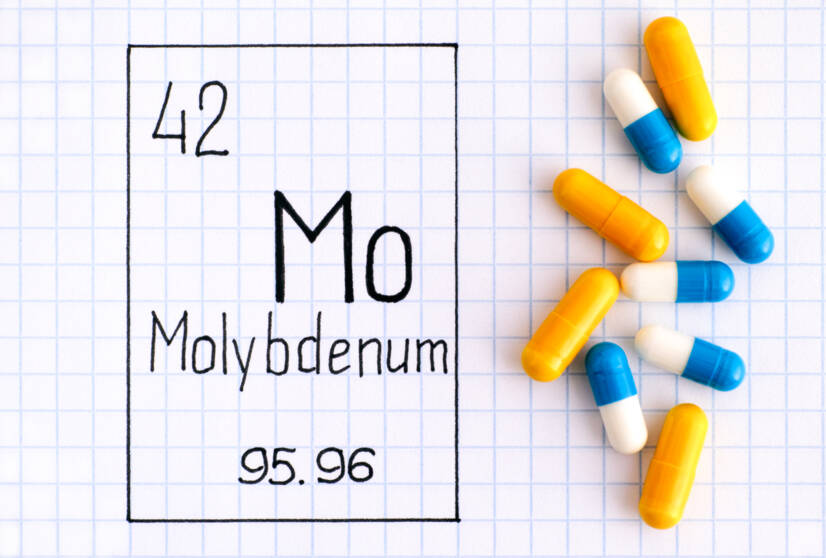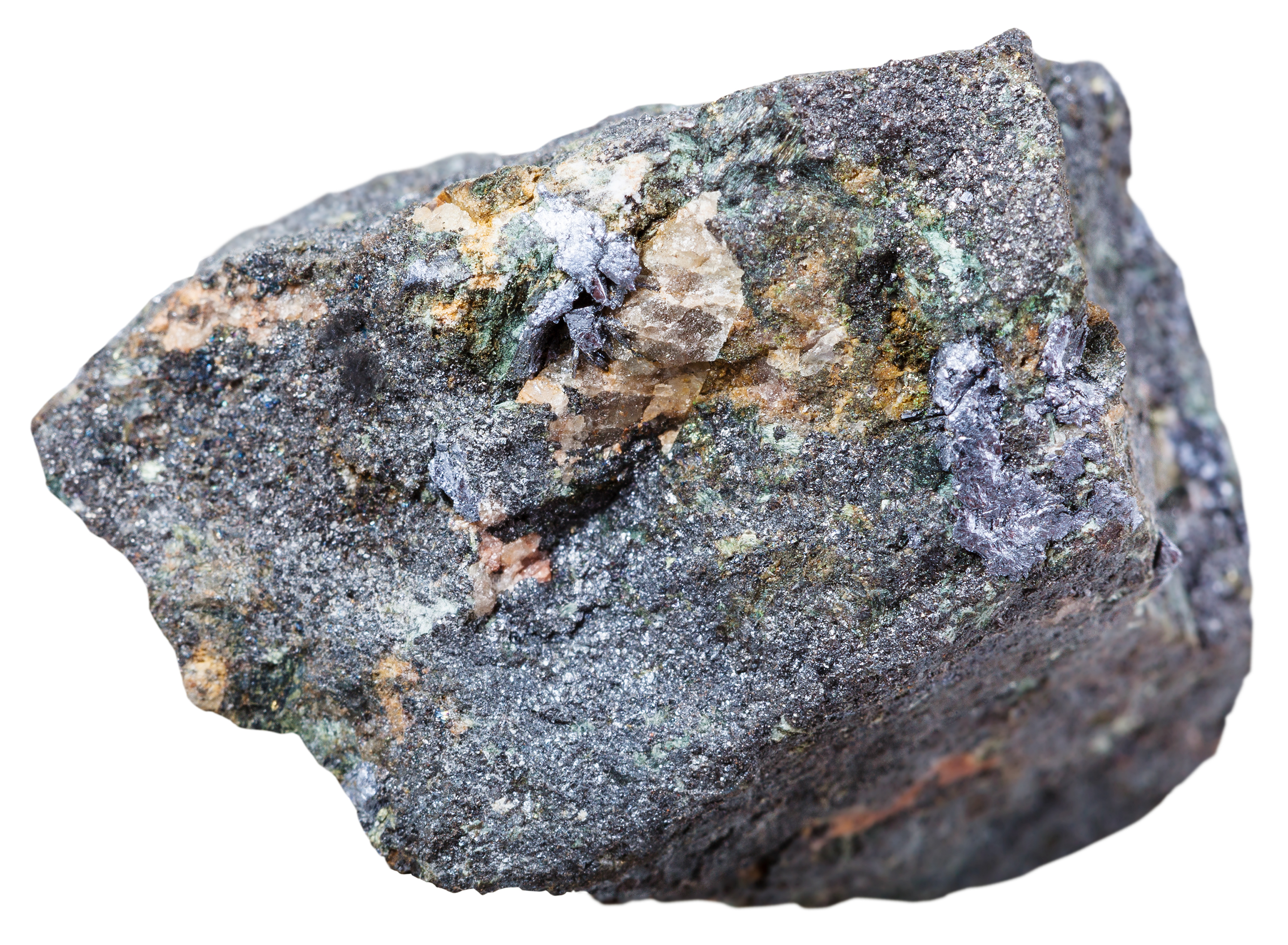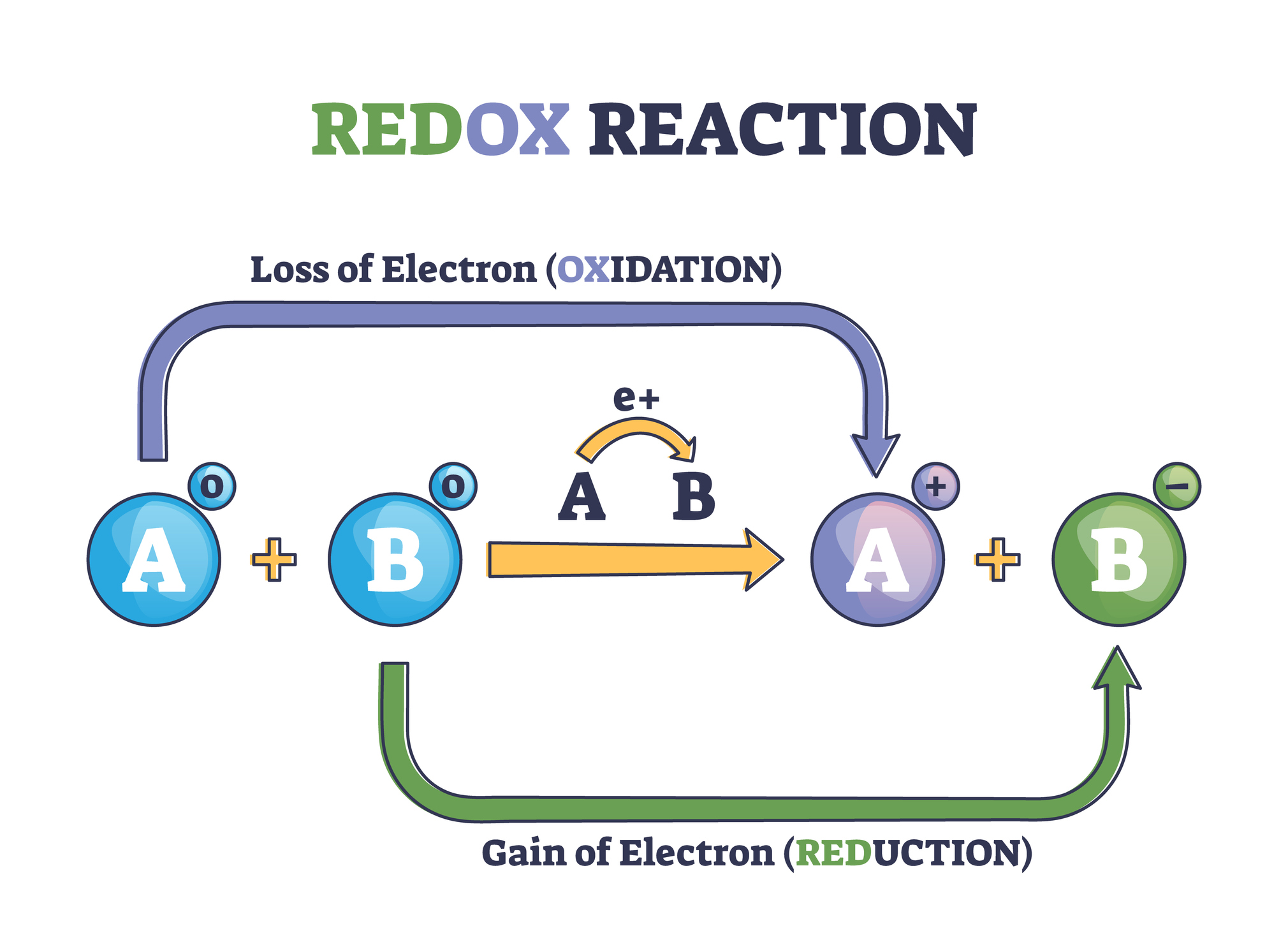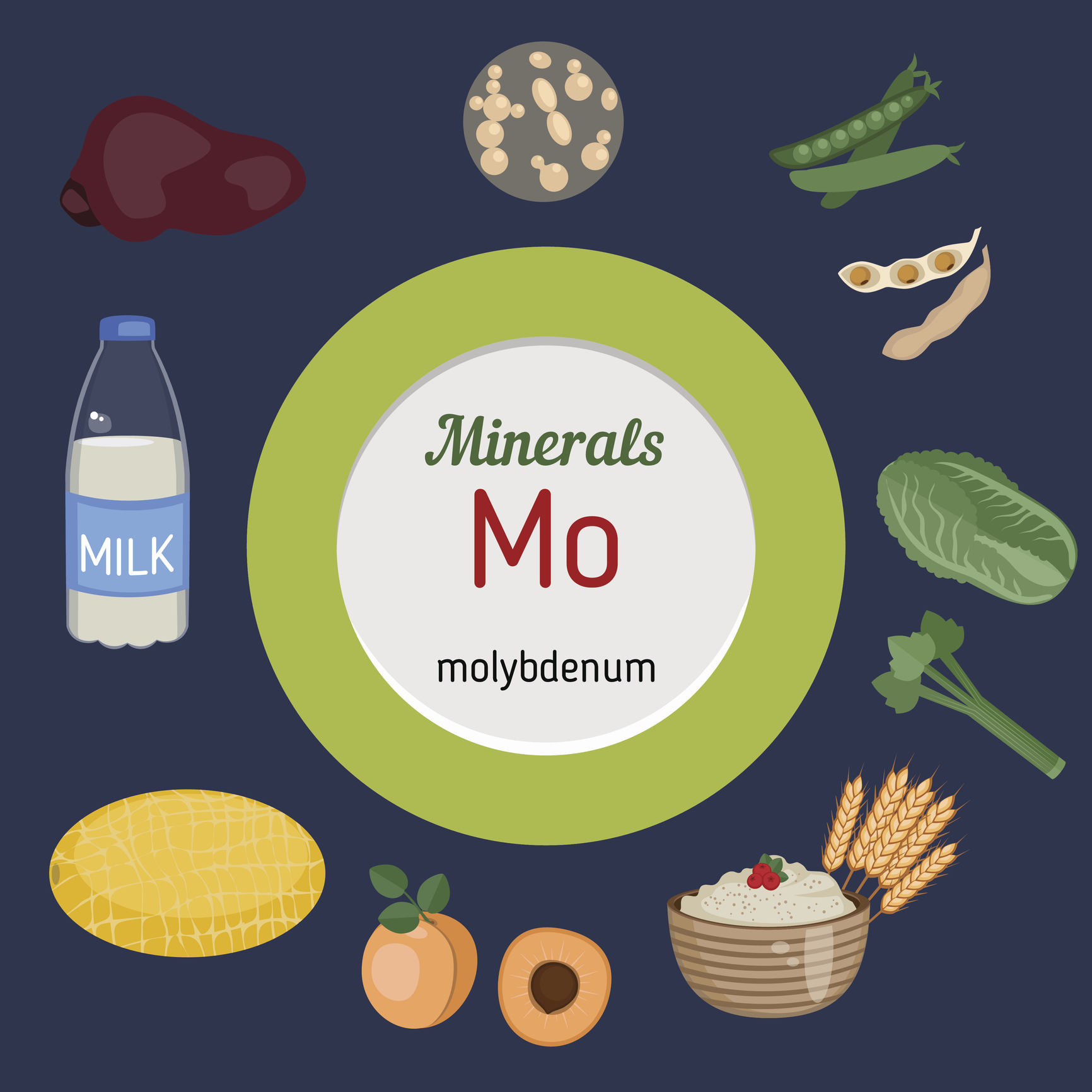- pubchem.ncbi.nlm.nih.gov - Molybdenum
- britannica.com - Molybdenum
- ncbi.nlm.nih.gov - Molybdenum, Janet A Novotny, Catherine A Peterson
- sciencedirect.com - Molybdenum, Jonas Tallkvist, Agneta Oskarsson
- pubmed.ncbi.nlm.nih.gov - Molybdenum cofactor and human disease, Guenter Schwarz
- pubmed.ncbi.nlm.nih.gov - Metabolism of molybdenum, Ralf R Mendel
- pubmed.ncbi.nlm.nih.gov - Cell biology of molybdenum, Ralf R Mendel
- lpi.oregonstate.edu - Molybdenum
- multimedia.efsa.europa.eu - Dietary Reference Values for the EU
Molybdenum: What are its effects on the body? Food sources + symptoms of deficiency and excess

Did you know that molybdenum also helps us process the cheese, fruit or glass of wine we consume? Read about the function of molybdenum in the human body, its benefits and possible risks.
Article content
Basic characteristics of the element
Molybdenum is an essential chemical element. It is a key component of living organisms, essential for their survival.
It has the chemical symbol Mo, which is derived from the Latin word molybdaenum.
Its name comes from the ancient Greek word "molybdos", which translates as lead. This misnomer is based on the fact that people often confused molybdenum ores with lead or graphite ores based on the same appearance.
Moreover, the name lead was the universal name in ancient times for any blackish-grey mineral that left traces on paper or other surfaces.
The history of the discovery of molybdenum dates back to 1778, when Swedish chemist Carl Wilhelm Scheele identified it as an unknown element in the mineral molybdenite.
However, people knew this mineral much earlier, precisely because it was long mistaken for lead ore or graphite.
Molybdenum was first isolated as a metal in 1781 by the Swedish chemist Peter Jacob Hjelm, who also gave it its name.
Molybdenum is an element of group 6 of the periodic table of chemical elements and is found in period 5.
It is classified in a group of elements called transition elements or also transition metals.
This name comes from a time when chemists attributed to elements in the middle of the periodic table the transitional properties between alkali metals and non-metals.
Molybdenum is a shiny metal with a silver-grey colour. It is malleable and highly resistant to corrosion.
It has one of the highest melting points of all the elements. It does not react with water or air at normal temperatures.
A tabular summary of basic chemical and physical information about molybdenum
| Name | Molybdenum |
| Latin name | Molybdaenum |
| Chemical name | Mo |
| Classification of elements | Transition metal |
| Grouping | Solid |
| Proton number | 42 |
| Atomic mass | 95,95 |
| Oxidation number | +2, +3, +4, +6 |
| Density | 10,2 g/cm3 |
| Melting point | 2623 °C |
| Boiling point | 4639 °C |
Molybdenum is an element widespread in the universe, in the Earth's crust, water, soil, and ultimately performs important functions in living organisms, including the human body.
Molybdenum does not occur in nature in free form. It is most commonly found in minerals, such as molybdenite (MoS2), wulfenite (PbMoO4), powellite (CaMoO4) and ferrimolybdite.
In terms of industrial use, the largest proportion of molybdenum produced is used in metallurgy in the production of alloys (e.g. cast iron, steel).
Molybdenum gives the resulting products unique strength, hardness, electrical conductivity and resistance to wear or corrosion.
In addition, molybdenum and its compounds can be used as:
- Part of electrodes, electrical or electronic components, due to its high melting point
- An effective solid lubricant, especially at high temperatures (at which oils decompose)
- Catalyst in the petroleum industry
- A substance that improves the adhesion of paints and varnishes to metals
- Pigment in plastics or ceramics
- Fertilizer for plants
- Part of animal feed
- Radioactive isotope in medical imaging

What is the biological function of molybdenum?
Molybdenum is one of the essential trace elements of the human body. It is needed only in trace, i.e. small, amounts. Its presence is nevertheless essential and its deficiency can have fatal consequences.
The body cannot produce molybdenum on its own and is dependent on its intake from the external environment.
The need for molybdenum in the human body is closely related to the functioning of certain enzymes. Molybdenum acts as a cofactor for these enzymes, which in turn can be involved in accelerating various chemical reactions - so-called catalysis.
Cofactors are low-molecular-weight chemicals that are attached to the enzyme molecule (they are the non-protein component of the enzyme). Their importance lies in the fact that they are essential for the function of enzymes. Without their presence, enzymes would show no activity.
The main role of cofactors is to transfer atoms or groups of atoms during the chemical reaction in which the enzyme is involved.
The biological importance of molybdenum was essentially only described with the discovery of the first molybdenum-containing enzymes in the 1950s.
Molybdenum as a single element has no role in the organism because it is inactive in this form. It only becomes significant when it forms a complex with an enzyme.
It follows that the biologically active form of molybdenum in our body is an organic molecule - the molybdenum cofactor.
There are two types of molybdenum cofactors, which differ significantly in structure.
The first is the iron ion-containing molybdenum cofactor (abbreviated FeMoCo), which is part of the enzyme nitrogenase. This enzyme does not affect humans but is found in some bacteria. It serves to fix nitrogen from the atmosphere.
The second type is a pterin-based molybdenum cofactor (abbreviated MoCo). It is a component of more than 100 different types of enzymes, including those in the human body.
In humans, only 4 enzymes have so far been identified that require the presence of molybdenum as a cofactor for their activity - namely sulphide oxidase, xanthine oxidase, aldehyde oxidase and the mitochondrial amido-reduction component.
They are also called metalloenzymes. Their role is to catalyse (i.e. accelerate) the oxidation-reduction reactions of compounds containing elements such as sulphur, carbon or nitrogen.
Sulfide oxidase is an enzyme that catalyzes the conversion of SO32- sulfites to SO42- sulfates.
This reaction is an important step in the process of breaking down and degrading sulfur-containing amino acids, i.e. cysteine and methionine in the body.
A deficiency of sulfide oxidase can lead to the development of serious neurological disorders.
Sulphide oxidase is even involved in the degradation of sulphites in food. Sulphites are common additives in foods - wine, drinks, cheese or fruit - where they act as preservatives or antioxidants.
The enzyme xanthine oxidase catalyses the breakdown of purines, which are the building blocks of the nucleic acids DNA and RNA. The end product of this breakdown reaction is uric acid.
The absence of xanthine oxidase in the body can lead to toxicity and even damage to the genetic information of cells.
The importance of aldehyde oxidase lies primarily in its involvement in the metabolism of drugs and toxic compounds. In addition, it catalyzes hydroxylation reactions of compounds of various natures.
The quartet of molybdenum-containing enzymes is completed by an enzyme called mitochondrial amidoxime reducing component (mARC).
This enzyme is involved in the metabolism of drug precursors.
A drug precursor is an inactive form of a drug that, once taken into the body, is metabolized to form an active drug capable of acting as a product.
Drug precursors are most commonly formed by the introduction of an oxygen atom into the active drug molecule. The enzyme mARC can reduce this oxygen bond in the molecule and is thus responsible for the formation of the active form of the drug.
In addition to the primary functions of molybdenum enzymes mentioned above, we can also mention their involvement in the reduction of nitrite to nitric oxide, which in turn regulates blood vessel contraction, blood pressure, cellular respiration and protection of cells from stress.

Molybdenum - from intake to excretion
Absorption
The main route by which molybdenum enters the body is through the intake of molybdenum in food or drinking water.
In order for molybdenum to be absorbed through the digestive tract, it must be in the hexavalent form Mo6+, most often in combination with oxygen as oxyanion.
The site of absorption is the stomach and small intestine. The higher absorption rate is in the small intestine.
Molybdenum is absorbed relatively rapidly and accounts for approximately 88-93 % of total dietary intake.
The amount of molybdenum absorbed depends not only on the amount of molybdenum in the diet, but also on the composition of the food consumed at the same time.
In the case of simultaneous intake of copper and sulphates, insoluble complexes of molybdenum, sulphur and copper are formed, and absorption of these elements is prevented.
Distribution
Absorbed molybdenum leaves the digestive tract and enters the blood, from where it is distributed to various parts of the body.
It is usually in the form of Mo4+ or Mo6+ and is bound to sulphur or oxygen.
Approximately 9 mg of molybdenum is found in the body of an adult. Most of this is as part of molybdenum enzymes. The largest amounts are concentrated in the liver, kidneys, small intestine and adrenal glands.
However, it is also found in teeth or bones.
The physiological concentration of molybdenum in the blood is approximately 0.6 ng/ml. However, its value also depends on the dietary intake of molybdenum.
Pathologically elevated blood concentrations of molybdenum are observed in patients with acute inflammatory liver diseases caused by viruses and in patients with alcohol-induced liver damage.
Excretion
The main route of excretion of molybdenum is urine. The higher the dietary intake of molybdenum, the higher the rate of excretion.
The regulation of molybdenum excretion is the most important step in maintaining molybdenum homeostasis, i.e. maintaining molybdenum levels at physiological levels.
A small amount of molybdenum is also removed from the body in the faeces. This is mainly the proportion that has not been absorbed in the digestive tract and is excreted directly from the body.
Elimination via bile should also be mentioned. Together with bile, molybdenum enters the intestines and is subsequently eliminated from the body again in the faeces.
The process of molybdenum excretion is probably influenced by the presence of copper and sulphate in the body. This interaction leads to increased excretion of molybdenum by the kidneys into the urine.
What is the recommended daily intake of molybdenum?
Recommendations for the average daily intake of molybdenum have not been established due to lack of data.
However, the European Food Safety Authority publishes values for adequate intake of molybdenum. Adequate intake is an average value based on observation. It is assumed to be adequate for the needs of the population.
In addition, there is also an upper limit of intake of molybdenum that is still tolerable for humans.
This limit represents the maximum long-term daily intake of molybdenum from all sources at which there is no risk of adverse health effects.
Tabular summary of adequate daily intake and upper limit of intake of molybdenum by age
| Age group | Adequate intake of molybdenum | Upper intake limit for molybdenum |
| Infants (aged 7-11 months) | 10 µg/day | Not applicable |
| Children aged 1-3 years | 15 µg/day | 0.1 mg/day |
| Children aged 4-6 years | 20 µg/day | 0.2 mg/day |
| Children aged 7-10 years | 30 µg/day | 0.25 mg/day |
| Adolescents aged 11-14 years | 45 µg/day | 0.4 mg/day |
| Adolescents aged 15-17 years | 65 µg/day | 0.5 mg/day |
| Adults (aged ≥ 18 years) | 65 µg/day | 0.6 mg/day |
| Pregnant women (≥ 18 years) | 65 µg/day | 0,6 mg/day |
| Breastfeeding women (≥ 18 years) | 65 µg/day | 0.6 mg/day |
Dietary sources of molybdenum
The most important source of molybdenum for humans is food and, to a lesser extent, drinking water.
Foods rich in molybdenum are mainly legumes (beans, peas, lentils), leafy vegetables, cereals and cereal products (wheat, oats), rice, nuts, sunflower seeds, milk and dairy products.
To a lesser extent, meat and offal, e.g. liver.
The molybdenum content varies from food to food. It depends on the type of food and also on the molybdenum concentration in the soil on which the plant food was grown. In the case of animal products, it depends on the nature of the animal feed.
More alkaline soils usually contain higher levels of molybdenum.
Dietary supplements can also be a source of molybdenum. Currently, only multi-ingredient preparations containing molybdenum among other ingredients are available on the market.
These are various multivitamin or mineral supplements. In these, molybdenum is found in the form of ammonium molybdate or sodium molybdate.
However, it is also usually used in the form of chlorides or citric acid salts.

What are the consequences of molybdenum deficiency?
As with other minerals or trace elements, it is important to maintain molybdenum concentrations within the physiological range.
Only then can this element be beneficial and safe for the body.
Any significant deviation from the established values can result in the onset and development of health complications.
Two situations can occur - the occurrence of excessive amounts of molybdenum in the body or, on the contrary, its deficiency or insufficient function.
Molybdenum deficiency and its consequences
The body's supply of molybdenum is mainly through food.
It is therefore logical that insufficient intake of foods rich in molybdenum may be the first cause of a molybdenum deficiency.
However, deficiency of molybdenum in the body due to low dietary intake is rare and almost non-existent in humans.
The only recorded case (1981) in which a deficiency developed as a result of low molybdenum intake was a patient with Crohn's disease who received total parenteral nutrition without molybdenum supplementation for several months.
Symptoms observed in this patient were nausea, rapid breathing and heart rate, vision problems and coma. Laboratory tests revealed impaired uric acid production and impaired metabolism of sulphur-containing amino acids.
The existence of impaired molybdenum function is much more likely compared to a deficiency of molybdenum in the body.
In this case, a sufficient amount of this trace element is taken into the body, but even so, it does not function properly.
In order for molybdenum activity to occur, it must be part of an enzyme in the form of a molybdenum cofactor - MoCo.
The process of MoCo formation consists of several steps. Any error in this process will cause incorrect synthesis of MoCo.
Since MoCo is an essential component of the four enzymes already mentioned, a failure in its formation will consequently have a negative effect on the functioning of the molybdenum enzymes.
Defects in the correct synthesis of MoCo are called mutations (more than 60 species have been identified). They are very rare birth defects.
Mutations in MoCo formation can lead to dysfunction of either all molybdenum enzymes or only one particular one.
The consequences of poor molybdenum enzyme function are:
- Sulfide oxidase deficiency
- Accumulation of sulfur compounds in the body (because they are not broken down by the enzyme)
- The occurrence of neurological disorders and severe developmental delay in the individual
- Deficiency of xanthine oxidase
- Accumulation of purine derivatives in the body and in the urine (because they are not degraded by the enzyme)
- Low blood uric acid levels (reduced antioxidant function of the blood)
- Deficiency of all enzymes
- Problems with eating, seizures, excessive crying, change in lens position occur in newborns
- In the first years of life, individuals cannot move, do not communicate with the environment, are dependent on feeding, and their overall mental development is arrested
- Usually ends in death in the first years of life
Excess molybdenum and its consequences
Molybdenum itself and its compounds do not pose a significant risk to the human body, even at high doses. The likelihood of molybdenum-induced toxicity is relatively low.
Several cases have been reported where excessive intake of molybdenum (due to its high concentration in the soil) has led to symptoms such as joint pain, increased uric acid in the urine, increased molybdenum in the blood or gout-like symptoms.
The nature of these symptoms suggests that increased molybdenum intake also increases the production and activity of molybdenum enzymes.
Serious molybdenum toxicity has so far only been observed in animals, specifically in ruminants.
Excessive molybdenum intake reduces the rate of copper absorption due to the formation of non-absorbable complexes.
Secondary copper deficiency occurs and this disease is called molybdenosis or hypocuprosis. It is manifested by severe diarrhoea, inappetence, greying of the coat, stiffness of the limbs, anaemia and even infertility.
The development of copper deficiency from ingestion of excessive doses of molybdenum can therefore also be a risk to humans, but is very rare.
Interaction of molybdenum with copper is currently used in the treatment of Wilson's disease, a disorder of copper metabolism in which excessive accumulation of copper in the body occurs. Administration of molybdenum reduces the proportion of free copper in the blood, thereby preventing its deposition in the tissues and toxicity
Interesting resources
Related










